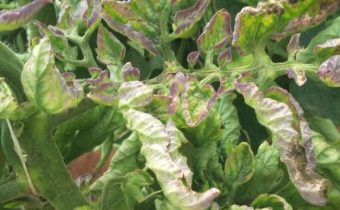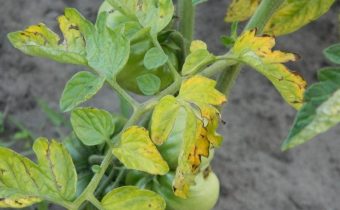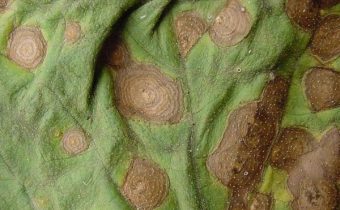Symptoms of Bacterial Cancer of Tomatoes
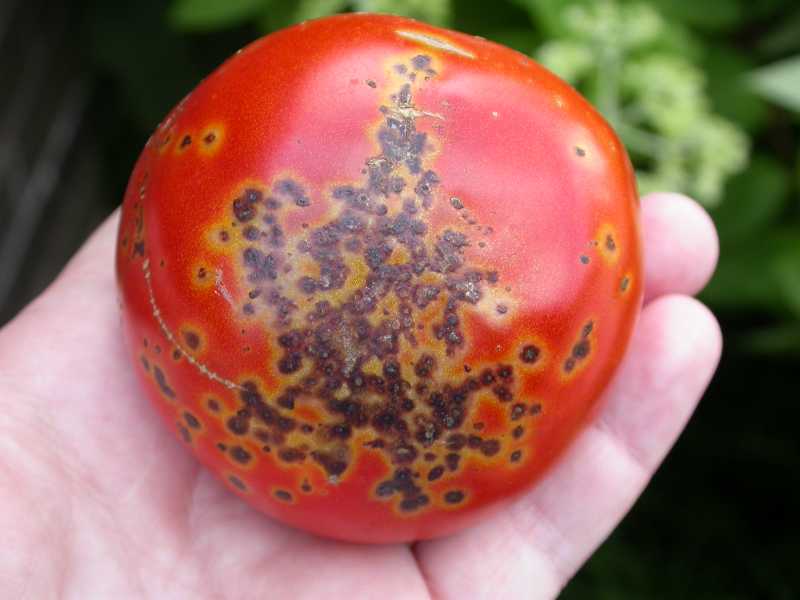
Bacterial cancer of tomatoes leads to a loss of 1/3 of the crop, if preventive and therapeutic measures are not promptly taken. Its pathogen is a rod-shaped bacterium, the first signs of activity of which are visible only with the onset of active fruiting.
Infection occurs through small cracks resulting from mechanical damage. Greenhouse tomatoes are at a greater risk of infection. In open ground bacterial cancer almost never occurs. The catalyst for the development of bacteria will become a stable temperature above + 25 ° C and an increased level of humidity.
Stages of formation of the clinical picture
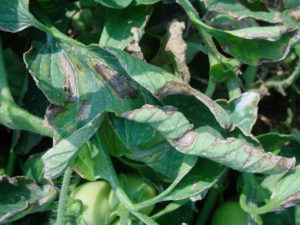 Stable temperature background - the main ally of the bacterial pathogen. It is necessary for the thermometer column to rise above the + 50C mark, as there will be no trace of the pathogenic environment. The deadly danger to the pathogen is a sudden cold. As soon as the microorganism enters the active phase, the active development of the diffuse or local form begins. Their features are reflected in the table.
Stable temperature background - the main ally of the bacterial pathogen. It is necessary for the thermometer column to rise above the + 50C mark, as there will be no trace of the pathogenic environment. The deadly danger to the pathogen is a sudden cold. As soon as the microorganism enters the active phase, the active development of the diffuse or local form begins. Their features are reflected in the table.
| Local | Diffuse |
| Overhead part of the bush is covered with ulcers. | Petioles covered with longitudinal stripes. |
| Fruits are covered with light spots, similar in shape to the bird's eye. | Over the course of several days, the strips alternate with ulcers. |
| Seeds can be used for subsequent sowing. | The stem gradually dies off. |
| The shape of the tomatoes does not change. | The shape of the fetus changes in a pathological way. |
| Tomato seeds turn black. | |
| The use of such seed is repeatedly prohibited. |
Before taking any measures, it is necessary to conduct a detailed examination of the affected seedlings. Reckless actions provoke a lot of problems.
Clinical manifestations of bacterial cancer
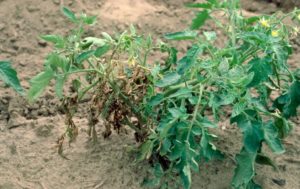 The onset of the active phase depends on the method of penetration of the pathogen into the seedlings. In addition to the mechanism described above affecting mechanical damage to tomatoes, the problem will be caused by infected seeds. Up to a certain point, residues of bacteria can remain on their surface or inside, so the seed material is carefully selected. Even if it was purchased at a specialty store, before planting the seeds are soaked in a 1% solution of potassium permanganate for 2-3 minutes.
The onset of the active phase depends on the method of penetration of the pathogen into the seedlings. In addition to the mechanism described above affecting mechanical damage to tomatoes, the problem will be caused by infected seeds. Up to a certain point, residues of bacteria can remain on their surface or inside, so the seed material is carefully selected. Even if it was purchased at a specialty store, before planting the seeds are soaked in a 1% solution of potassium permanganate for 2-3 minutes.
In the case when the infection could not be avoided, the symptoms appear gradually. Unfortunately, it is almost impossible to detect the disease at an early stage, so the bacterial pathogen gets time to develop. The first form of its manifestation is the formation of characteristic sores on one side of the leaf. To speed up the process will help uneven watering bush tomato.
As a rule, ulcers are fixed with the beginning of the formation of the first ovaries.
To continue the list of symptoms of bacterial cancer in tomatoes the following details:
- casting over time acquire a reddish tint;
- gradually clog the vessels of the bush, which leads to its withering;
- future fruits become elongated or flattened.
As soon as the listed symptoms have been felt, treatment should begin immediately.
Carriers and other causes of the disease
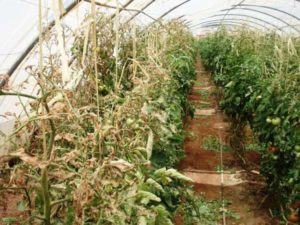 A sedentary type of rod-shaped bacteria penetrates tomatoes in two ways.The first is through microscopic cracks. Before the onset of favorable conditions, the pathogen is in a "dormant" state. The catalyst of the process is the increased level of humidity and temperature within + 23 + 25С. The list of causes of bacterial cancer will complement the factors listed below:
A sedentary type of rod-shaped bacteria penetrates tomatoes in two ways.The first is through microscopic cracks. Before the onset of favorable conditions, the pathogen is in a "dormant" state. The catalyst of the process is the increased level of humidity and temperature within + 23 + 25С. The list of causes of bacterial cancer will complement the factors listed below:
- use of infected seeds;
- unsatisfactory soil condition - after each harvest, disinfection is carried out;
- frequent temperature changes in the greenhouse;
- not timely removal of weeds and plant debris - the pathogen overwinters in the soil, therefore, it is impossible to prevent the formation of waste.
Completes the list of reasons - mistakes gardener. Soil that does not dig, will be a good environment for the development and wintering of the pathogen. The second common mistake gardener - the lack of regular inspection of the status of seedlings. One has only to water the infected plant or spray it with pesticides, as the bacteria will be on the neighboring bushes.
Effective treatment methods
Pathology is easier to prevent than to win, so at the stage of choosing the seed is to be careful. In addition to using the solution of potassium permanganate, a 0.2% solution of the “Fitolavin-300” preparation will help to disinfect the seed. For every 1 liter of water is taken 150 ml of the drug. Another alternative is formalin. The solution is prepared in a ratio of 1: 100. Regardless of the use of certain preventive measures, the gardener must permanently monitor the seedlings.
With the appearance of the first symptoms, it is necessary to immediately remove from the greenhouse or beds the diseased plants that are burned, otherwise the bacteria cannot be destroyed. Every 3 weeks, prophylactic spraying of seedlings with a 0.2% solution "Fitolavin-300" is carried out. The recommended dosage is 150 ml of the drug per bush. After harvesting, the soil is obligatory disinfected - 250 ml of the substance are taken for every 10 liters of water.
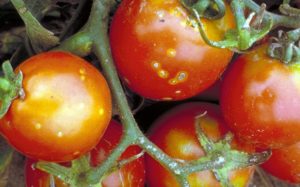 If desired, it is replaced by formalin - 1:50. Disinfection with the use of similar products is subject not only to the soil, but also all garden tools. In addition to these biological methods of dealing with the disease, botanists emit chemical ones. 24 hours before sowing, seeds are soaked in TMTD suspension. Another 1 way - metered use of substances containing copper. It is about Bordeaux mixture and blue vitriol. The optimal time for processing is from 10 to 12 and from 16 to 18 hours. The recommended concentration level is 100 ml.
If desired, it is replaced by formalin - 1:50. Disinfection with the use of similar products is subject not only to the soil, but also all garden tools. In addition to these biological methods of dealing with the disease, botanists emit chemical ones. 24 hours before sowing, seeds are soaked in TMTD suspension. Another 1 way - metered use of substances containing copper. It is about Bordeaux mixture and blue vitriol. The optimal time for processing is from 10 to 12 and from 16 to 18 hours. The recommended concentration level is 100 ml.
Prevention of Bacterial Cancer in Tomatoes
Gardener conducts inspection of landings at least 1 time every 2-3 weeks. As soon as the stems or leaves show signs of bacterial cancer, the entire shrub must be disposed of. It is not thrown into the urn, and burned. Not prolonged temperature exposure ensures the death of bacteria. Removal of the affected tomato bush is produced only with a minimum level of humidity. Every 14 days, as a preventive measure, the gardener conducts foliar treatment of the plant. The procedure is as follows:
- manipulation is performed from 6 to 8 or between 15 and 18 hours;
- 500 ml of a solution of copper sulphate or copper perchloric acid;
- 100 g of urea;
- add copper sulphate - in proportions of 0.1 g / 1l.
This solution is made under each bush immediately after watering. Intensity of application - 1 time every 5-7 days.
Initially, the gardener performs the planned work with 100% healthy bushes, and then switches to the affected or potentially sick. Compliance with the rule reduces the likelihood of the spread of a bacterial pathogen. After completion of work on the site, all used material is disinfected in a solution of potassium permanganate. If desired, it can be replaced with a solution of copper sulfate. The duration of the inventory in the bath - 20 minutes.
Removal of stepsons and leaves is allowed only with garden tools. Every action needs to be controlled, otherwise negligence will damage the seedlings.The gardener should be aware that this activity is prohibited to carry out at a high level of humidity or after watering. Moisture - the best nutrient medium for the pathogen. Do not lose sight of the soil. To reduce the likelihood of the development of bacteria in the soil will help some practical tips:
- after each harvest, the soil is disinfected with a mixture of carbathion and water in a ratio of 250 ml for every 10 liters;
- if bacterial cancer in tomatoes was previously recorded on its own or neighboring plot, then the soil is necessarily replaced.
Before planting the seeds, they are lowered for 30 minutes into a container with water, the temperature of which is + 45 + 50С.
Another way to prevent the development of bacterial cancer in tomatoes is to use resistant varieties. Their list is as follows:
- "Charisma F-1";
- Vologda;
- "Ural";
- "Firebird".
Tomato bacterial cancer is a disease tolerated by infected seeds, so the grower must be careful in choosing a seed. The second precautionary measure is regular soil and plant treatment. Unfortunately, even with the observance of the above recommendations, one cannot be 100% sure of a positive result, so a detailed inspection of the landings is carried out every 4-5 days. As soon as the affected areas are noticed, the entire shrub is immediately removed.


